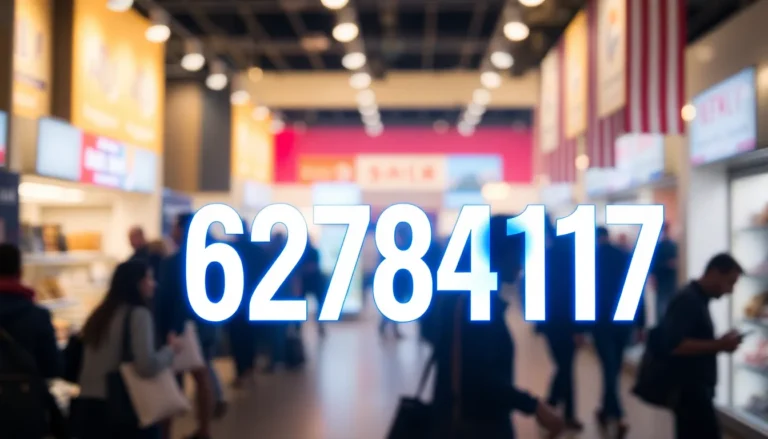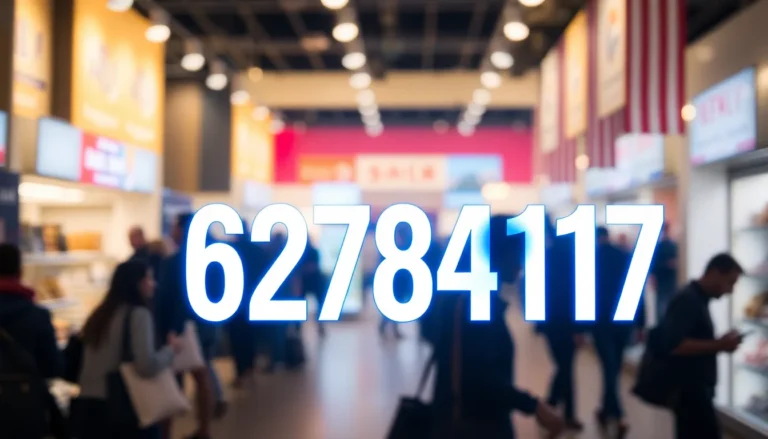Table of Contents
ToggleIn today’s fast-paced world, consumer spending trends are like a rollercoaster ride—full of twists, turns, and unexpected drops. As people navigate their financial decisions, understanding these trends can feel like trying to solve a Rubik’s Cube blindfolded. But fear not! With a little insight, anyone can decode the patterns behind what people are buying and why.
Overview of Consumer Spending Trends
Consumer spending trends reflect the shifting behaviors of individuals and households. Factors influencing these trends include economic conditions, technological advancements, and social changes. The unpredictability noted in previous discussions contributes to the complexity of these spending patterns.
Recent data reveals that in 2022, U.S. consumer spending reached approximately $14 trillion, marking a 7% increase from the previous year. Rising inflation, however, places pressure on purchasing power. To illustrate, essential categories like food and housing account for about 60% of average household expenses, leaving less disposable income for discretionary items.
Digital shopping has accelerated significantly. E-commerce sales represented 14% of total retail spending in 2021. This figure is projected to rise, driven by convenience and wider access to products. Emerging payment methods, like mobile wallets and buy-now-pay-later services, also reshape consumer preferences.
Demographics play a critical role in spending trends. Millennials, for instance, prioritize experiences over material goods, while Generation Z favors sustainability in their purchases. These distinct preferences often drive brand loyalty and influence retailers to adapt their marketing strategies.
Additionally, consumer sentiment affects spending behavior. Surveys indicate that confidence tends to fluctuate based on economic indicators, such as unemployment rates and GDP growth. When consumer confidence is high, spending typically increases, fostering further economic growth.
Understanding consumer spending trends requires analyzing various factors ranging from economic conditions to shifts in preferences. By focusing on these elements, businesses can better adapt to the evolving landscape and meet consumer needs effectively.
Factors Influencing Consumer Spending

Multiple factors shape consumer spending patterns, including economic indicators and consumer confidence levels. Understanding these elements provides insight into purchasing behaviors.
Economic Indicators
Economic indicators play a pivotal role in consumer spending. GDP growth rates, unemployment figures, and inflation trends directly affect how much households spend. When GDP rises, consumers tend to increase discretionary spending due to higher incomes and job security. Conversely, high unemployment often leads to reduced spending as individuals prioritize essential expenses. In 2022, rising inflation impacted purchasing power, pushing consumers to adjust their budgets and limit expenditures on non-essential items. Consequently, businesses must monitor these economic signals to anticipate shifts in consumer behavior.
Consumer Confidence
Consumer confidence significantly influences spending decisions. Higher confidence levels correlate with increased willingness to spend, as consumers feel secure about their financial situations. The Conference Board’s Consumer Confidence Index serves as a benchmark, providing insights into how consumers perceive current economic conditions and their expectations for the future. A drop in confidence results in cautious spending, affecting luxury and non-essential purchases. Businesses benefit from fostering positive consumer sentiment through effective marketing strategies, aligning their offerings with consumer needs and preferences.
Seasonal Variations in Spending
Consumer spending experiences significant fluctuations throughout the year, influenced by various seasonal events and trends. Understanding these variations aids businesses in aligning their strategies with consumer behavior.
Holiday Spending Patterns
Holiday seasons consistently drive substantial increases in consumer spending. In the U.S., holiday shopping reached nearly $886 billion in 2021, reflecting a 14% increase from the previous year. Consumers invest heavily in gifts, decorations, and festive meals during Thanksgiving and December holidays. Special sales events, such as Black Friday and Cyber Monday, attract millions, encouraging early and extensive purchasing. Emotional factors also play a role, as the spirit of giving boosts consumer willingness to spend on non-essential items.
Back-to-School Shopping Trends
Back-to-school shopping reveals its own distinct spending patterns. Parents and students typically allocate about $37 billion annually for supplies and clothing, with expenditures peaking in late July and early August. Essentials such as notebooks, backpacks, and clothing dominate purchases during this time. Many families budget for school technology, reflecting the growing need for digital devices in education. Promotions and sales from retailers further entice consumers, prompting increased attention to spending.
Impact of Technology on Consumer Behavior
Technology significantly reshapes consumer behavior, particularly through online shopping and payment preferences. The convenience of digital platforms impacts how households engage with retail.
Online Shopping Growth
E-commerce recorded substantial growth, reaching 14% of total retail spending in 2021. This trend accelerated due to the pandemic, pushing more consumers to embrace online purchasing. Online shopping’s convenience allows consumers to explore a broader range of products and compare prices easily. They favor the ability to shop anytime, avoiding crowded stores and long checkout lines. Innovations like personalized recommendations enhance customer experiences, driving repeat purchases. Retailers who optimize websites for mobile views see higher engagement rates. Ample data confirms that consumers respond positively to streamlined buying processes.
Mobile Payment Preferences
Mobile payment methods gained popularity as technology advances. Digital wallets, such as Apple Pay and Google Wallet, simplify transactions, appealing to tech-savvy consumers. Statistics show that a significant number of consumers prefer contactless payment options for their speed and convenience. Enhanced security features also contribute to growing confidence in mobile payments. A study indicated that 60% of smartphone users regularly utilize mobile payment apps. Greater acceptance at retail locations encourages customers to choose these options over traditional cash or card methods. Consumers increasingly lean toward using mobile payments for their everyday purchases, reshaping transaction landscapes.
Demographic Changes and Spending
Demographic shifts significantly influence consumer spending patterns. Each generation has distinct habits shaped by various economic and social factors.
Generation Z Spending Habits
Generation Z prioritizes sustainability in purchases. This group often seeks brands that align with their values, emphasizing eco-friendly products. Recent analysis shows that approximately 73% of Gen Z consumers are willing to spend more on brands committed to social and environmental causes. Convenience also plays a vital role in their shopping preferences. Many prefer online shopping platforms that offer seamless user experiences. Digital engagement, such as social media marketing, significantly impacts their brand loyalty. They frequently rely on peer reviews and influencer endorsements before making purchases. Understanding these preferences helps businesses tailor marketing strategies to attract Gen Z effectively.
Millennial Preferences
Millennials favor experiences over material goods. Travel and dining out often take precedence in their spending habits. Statistics reveal that about 67% of Millennials prioritize experiential purchases, indicating a shift from traditional consumerism. They show a strong preference for brands that offer personalization, enhancing their customer experience. With technological advancements, online shopping remains a staple for this generation, driven by convenience and competitive pricing. Additionally, many Millennials value transparency in business practices. They support companies that demonstrate ethical values and social responsibility. By recognizing these trends, businesses can develop strategies that resonate with Millennial consumers.
Future Predictions for Consumer Spending Trends
Emerging data suggests a pivotal shift in consumer spending practices. E-commerce will continue its robust growth, potentially surpassing 20% of total retail spending by 2025 as convenience remains a priority. Digital shopping trends show consumers favoring online platforms for their ease of use and extensive product options.
Technological advancements will play a crucial role in shaping preferences. Innovations like augmented reality may enhance shopping experiences, allowing customers to visualize products in their spaces prior to purchase. Enhanced personalization through artificial intelligence will likely increase consumer loyalty, with tailored recommendations driving repeat business.
Socioeconomic factors also pose significant implications for spending patterns. As inflation fluctuates, projected consumer spending could constrain particularly in discretionary categories. Financial pressures may lead households to prioritize essential goods over luxury items.
Generational differences in spending behaviors will persist. Generation Z’s commitment to sustainability suggests a potential increase in demand for eco-friendly products, with an estimated 73% willing to pay more for sustainable options. Millennials, with a focus on experiences, could maintain their trend of favoring travel and dining over material purchases.
Consumer confidence rates will undoubtedly impact purchasing decisions. Growing uncertainty in economic indicators may cause consumers to exercise caution in their spending habits. Monitoring data from sources like the Conference Board’s Consumer Confidence Index will help businesses adapt their strategies accordingly.
Seasonal spending patterns are set to evolve as well. Holiday shopping seasons may experience significant shifts in consumer behavior influenced by economic conditions. Businesses must prepare for these changes, optimizing marketing strategies during key retail periods to capture consumer interest.
Consumer spending trends are continually evolving as they reflect broader economic and social dynamics. The shift towards e-commerce and the growing importance of sustainability highlight the need for businesses to adapt to changing consumer preferences. As economic indicators fluctuate consumer confidence will play a critical role in shaping spending behaviors.
Understanding these trends allows businesses to align their strategies with consumer needs effectively. By staying attuned to the unique preferences of different generations and leveraging technological advancements companies can position themselves for success in an ever-changing marketplace.




